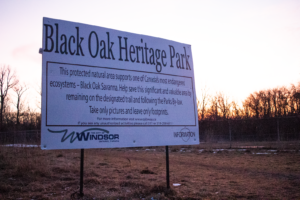Community concerned about future of Black Oak Heritage Park
By Matt Flood

The entrance of Black Oak Heritage Park. (Photo by Matt Flood)
The City of Windsor’s activity in Black Oak Heritage Park is causing concern for park goers.
Recent work, including prescribed burns and cutting of invasive species of trees over restricted trails, has community members growing concerned. For nearly 13 years this community of runners, cyclists and dog mushers, now known as Friends of Black Oak, worked with city naturalists as volunteers to preserve BOHP. But in 2015 the city began to work on the park as part of its parks master plan, Rediscover Our Parks .
The community gradually reduced approximately 18 km of natural trails to nine kilometres of city-approved trails between 2007 and 2015. The park closed in 2015 as construction preparations for the Gordie Howe International Bridge began, and dangerous structures including ramps, mounds and bridges made of natural materials were discovered. BOHP reopened in 2018. Most trails were restricted by the city, and the entire south section of the park has been fenced off. Currently, an approximately two kilometre trail is available for use as an environmental study is performed on the rest of the park.
Lindsay Cole is a team leader and administrator of the Friends of Black Oaks Heritage group.
“The community has been without their trails for over a year and they have been unable to have access to the park they’ve had for 20 years and I think they’re very very very concerned about what’s happening with the trees when they see live trees being cut,” said Cole.
BOHP is characterized by black oak savanna, black oak woodland, tallgrass prairie and many at-risk species of flora and fauna.
According to the City of Windsor’s website, tallgrass prairie is characterized by a low number of trees, approximately 2.5 trees per hectare. This information and the recent cutting of trees within BOHP has brought concern to Friends of Black Oak as they fear the park may lose its tree coverage.
But according to City Forester Paul Giroux, this is not an accurate assessment of the future of BOHP.
“We will be taking out the invasive species, there will be parts that perhaps once we just take the invasives out that it will open it up because that’s what it naturally was,” said Giroux. “But by no means are we going to go in there and start cutting down oak trees and taking away that forested feel.”
The recent cutting of trees in BOHP is a result of maintenance work from the city beginning in the winter months. According to Corporate Leader of Parks, Recreation, Culture and Facilities, Jan Wilson, the city removes dead, unhealthy and invasive tree species that are unsafe or inhibiting growth of natural species.
Regarding the restriction of trails within BOHP, Wilson asks for cooperation from the community.
“We obviously encourage people to be in the parks, we ask that they can work with us with respect to improving our parks so that they can be managed in a way that’s responsible from many different perspectives,” said Wilson. “We’ll have to see what the management plan comes back with so the consultant will bring forward some recommendations and options that will allow us to manage the area in a responsible way to protect the habitat.”
Currently, BOHP is undergoing an environmental study to determine what can be done with the park in the future.
Environmental consulting firm Sage Earth will finish their study in late spring. Once it is done the Parks and Recreation department will review their plan and bring it to city council for approval.
If it passes, the future of Black Oak Heritage Park and its trails will start to become more clear.


